Breast Augmentation Surgery in Hyderabad, India | Cost & Procedure Benefits
PACE Hospitals is recognized as the Best Hospital for Breast Augmentation Surgery in Hyderabad, India, offering personalized care and outstanding results, making it a premier choice for individuals seeking to enhance their natural beauty. Our team of highly skilled plastic surgeons is experienced in advanced breast enhancement techniques, aesthetically pleasing outcomes.
Using the latest technology and implant materials, we focus on precision and safety to achieve optimal results tailored to each patient’s body and goals. With state-of-the-art facilities, a patient-centered approach, and comprehensive pre- and post-operative care, strict safety protocols including an operation theater equipped with advanced monitoring equipment, to ensure successful surgeries and quick recovery. PACE Hospitals provides an exceptional experience for those seeking Best Breast Augmentation Surgery Hospital in Hyderabad.
Quick Links
• Understanding Breast Augmentation: Meaning and Overview
• Who Should Consider Breast Augmentation: Key Indications
• Essential Considerations Before Undergoing Breast Augmentation
• Contraindications: Who Should Avoid Breast Augmentation
• Exploring Different Types of Breast Augmentation
• Step-by-Step Guide to the Breast Augmentation Procedure
• Exploring Non-Surgical Options for Breast Augmentation
• Key Benefits of Choosing Breast Augmentation
• Potential Side Effects of Breast Augmentation Surgery
• Life After Breast Augmentation: What to Expect
• Breast Augmentation Surgery Cost
• Common questions & answers on Breast augmentation
Request an appointment for Breast Augmentation Surgery
Breast augmentation surgery appointment
Why choose us
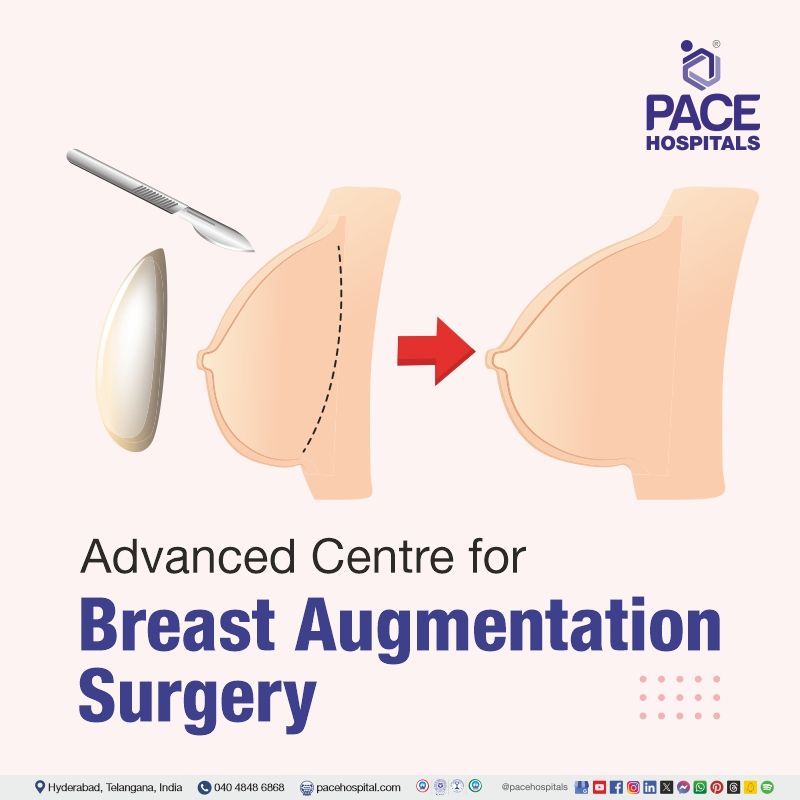
Advanced State-of-the-Art Surgical Techniques
Team of the Best Plastic Surgeons in Hyderabad
Precision Treatment with 99.9% success rate
All insurance accepted for cashless treatment
Breast augmentation meaning
Breast augmentation (augmentation mammoplasty) is surgical procedure that enhances the size or shape of the breasts. Augmentation can be achieved through the implantation of an implant or, less usually, fat transfer. In many women, breast development is often inadequate. As a result, women with “smaller than-normal breasts” and for other medical reasons like mastectomy believe they have a disproportionate figure and seek surgery to fix it.
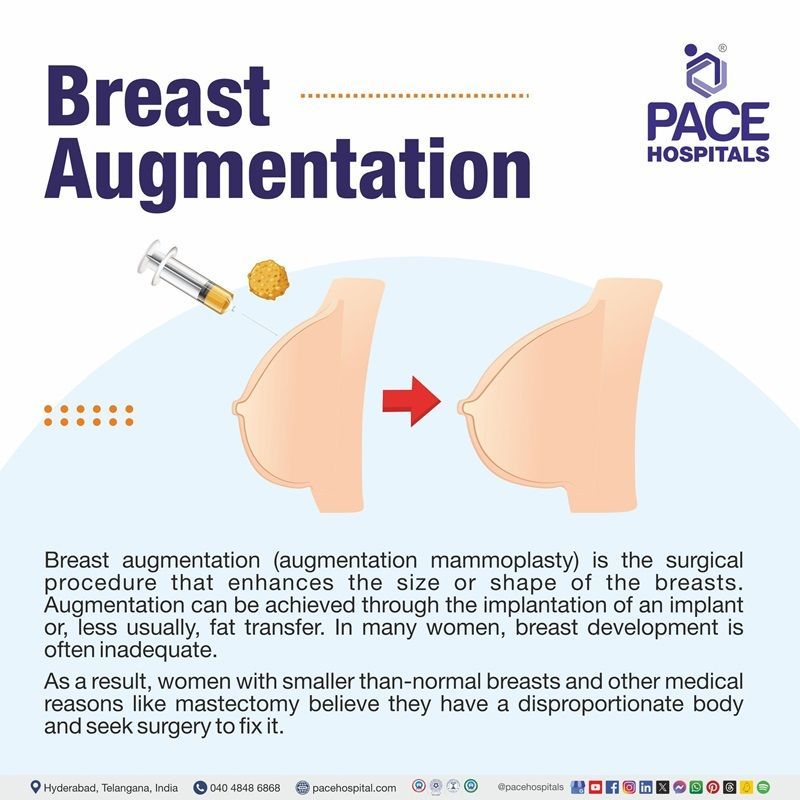
Indications of breast augmentation
Breast augmentation is indicated for various reasons in women as mentioned below:
- Aesthetic enhancement
- Reconstructive purposes
- Gender affirmation
- Revisional surgery
- Psychological and social factors
- Age- related changes
Aesthetic enhancement
Aesthetic enhancement is the alteration of a person's visual appearance, shape, or form, or the visual appearance of any of its components. The aesthetic enhancement with respect to breast augmentation is related to breast enhancement in women for the following reasons:
- Asymmetry correction: Natural breast asymmetry is common, and augmentation can help balance the size and shape of uneven breasts.
- Restoring Volume Post-Pregnancy or Weight Loss: Pregnancy, breastfeeding, or weight loss in women can decrease the breast volume. Augmentation can help restore the desired size and firmness.
Reconstructive purpose
Reconstructive surgery is a medical intervention approach used to correct anatomical deficiencies brought on by tumors, congenital abnormalities, aging, infections, and injuries. The reconstructive surgery with respect to breast augmentation will be:
- Post-mastectomy reconstruction: After the removal of one or both breasts due to breast cancer, reconstruction with implants can help restore the breast's appearance.
- Congenital Breast Deformities: Conditions such as Poland syndrome (absence or underdevelopment of chest muscles) or tuberous breast deformity can be addressed with augmentation.
Gender Affirmation
Gender affirmation surgery is a surgical procedure to change a person's physical appearance and functional abilities to align with their gender identity. This is done for the following purpose in:
- Transgender or Non-Binary Individuals: Those undergoing male-to-female transition may opt for breast augmentation as part of their gender-affirming surgery to achieve a more feminine chest contour.
Revisional Surgery
This is a procedure that corrects or modifies a previous surgery that may have failed to relieve pain or caused complications. Revision surgeries can be more complex than primary surgeries and can involve:
- Correction of Previous Breast Augmentation: Individuals may seek augmentation to correct issues from previous surgeries, such as implant displacement, capsular contracture, or dissatisfaction with size or shape.
Psychological and Social Factors
The key psychological or social factor that is linked to breast augmentation is to improve the self-confidence and self- image as mentioned here:
- Improvement in Self-Image and Confidence: Many individuals seek breast augmentation to enhance their self-esteem and body image, which may positively impact their social and professional lives.
Age-Related Changes
As age can affect the size and shape of the breast, this surgical procedure is performed for the following indications:
- Addressing Sagging or Volume Loss: As women age, natural changes in breast tissue may lead to sagging or loss of volume, which can be corrected or improved with implants.
Considerations before the breast augmentation
- Before undergoing breast augmentation, patients should have a detailed consultation with a qualified plastic surgeon.
- The consultation should cover the patient's goals, expectations, and the risks associated with the procedure.
- Surgeons will also consider the patient's overall health, breast anatomy, skin quality, and lifestyle factors to determine the most suitable approach.
- These indications highlight the diverse motivations and needs that drive individuals to seek breast augmentation. Each case should be evaluated individually to ensure that the procedure aligns with the patient's goals and expectations.
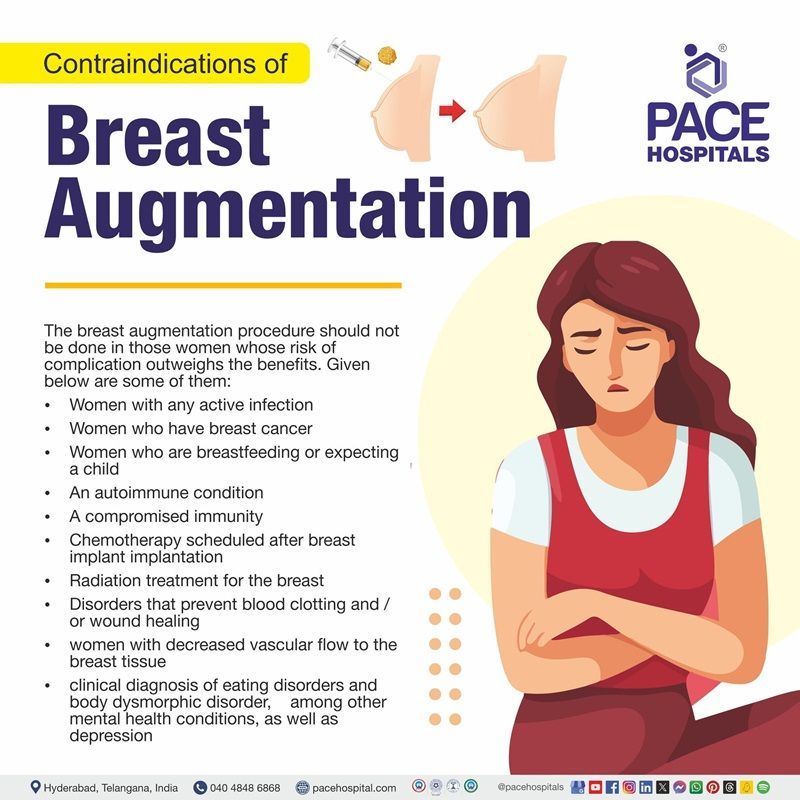
Contraindications of breast augmentation
The breast augmentation procedure should not be done in those women whose risk of complication outweighs the benefits. Given below are some of them:
- Women with any active infection
- Women who have breast cancer or pre-cancer and have not received proper treatment
- Women who are breastfeeding or expecting a child
- Autoimmune condition
- Compromised immunity
- Chemotherapy scheduled after breast implant implantation
- planned radiation treatment for the breast after the implantation of a breast implant
- Disorders that prevent blood clotting and/or wound healing
- women with decreased vascular flow to the breast tissue
- Clinical diagnosis of eating disorders and body dysmorphic disorder, among other mental health conditions, as well as depression.

Breast augmentation types
We have majorly two types of breast augmentation:
- Breast implants
- Augmentation by fat transfer
There are several possibilities depending on how you want your breasts to feel and look within those two categories. Only a specific age range is permitted for some kind of breast implants. Before choosing to get breast augmentation, it is crucial to conduct thorough research, weigh the benefits and drawbacks of each choice.
Breast implants
The most popular kind of breast augmentation is breast implants. Options for breast implants include:
- Saline breast implants: Sterile saline, or salt water, is used to fill these implants. If the implant burst within the woman's breast, the saline would be absorbed by the body and eliminated naturally.
- Structured saline breast implants: This structured saline breast implants are designed in a way to provide natural feel by filling it with sterile saline or salt water.
- Silicone breast implants: As the name suggests, silicone breast implants are made of silicone gel. If the patient chooses this type of implant, she is supposed to consult her plastic surgeon regularly to ensure that the implants are functional. Even if the implant breaks, the silicone gel would remain within the shell or spills into the patient's breast.
- Form-stable breast implants: These implants maintain their shape even if the implant shell cracks, which is why they are known as "gummy bear" breast implants. Compared to conventional implants, they are stiffer and composed of a thicker silicone gel. You must have a longer skin incision during surgery to receive form-stable breast implants.
- Round breast implants: Breasts appear fuller with these implants many a times better. If the implants go out of place, it usually doesn't affect the appearance of the breast because they are rounded all over.
- Smooth breast implants: Among all the various types of implants, these feel the softest. Compared to other implants, smooth breast implants can give the appearance of more natural breast movement.
- Textured breast implants: These implants reduce the likelihood of moving around inside the breast by causing scar tissue to cling to the implant. Although rare, breast implant-associated anaplastic large cell lymphoma (BIA-ALCL) is most common in patients with textured breast implants.
Fat transfer breast augmentation
In a fat transfer breast augmentation, the surgeon will use the technique of liposuction to collect fat from different areas of the patient's body and then inject that fat into their breasts. Fat transfer breast augmentation is commonly helpful for those who want to increase a smaller size of their breasts comparatively. The cosmetic surgeon would fetch the fat from fat rich areas of patient's body like belly, back, or thighs.
Breast Augmentation Procedure
Before the breast augmentation surgical procedure
The breast augmentation surgery is used to increase the size of the breast and its shape with the help of implants or fat transfer. Here's a step-by-step overview of the procedure:
Preoperative Preparation
- Consultation: The plastic surgeon meets the patient before the procedure to discuss goals, expectations, and options. The surgeon will assess the patient's health, breast anatomy, and skin quality.
- Choosing Implants: The patient and surgeon decide on the type (saline or silicone), size, shape (round or anatomical/teardrop), and surface texture (smooth or textured) of the implants.
- Preoperative Instructions: Patients may be advised to stop smoking, avoid certain medications, and fast before surgery. Preoperative imaging (e.g., mammogram) may be done.
- Informed Consent: Consent form is to be signed by the patient after understanding the procedure, risks, benefits, and alternatives.
During the breast augmentation procedure
The detailed step wise approach while performing the procedure of breast augmentation is as mentioned below:
Anesthesia: Most of the time, general anesthetic is used during breast augmentation procedures, which keeps the patient unconscious. Local anesthetic combined with sedation may be used in certain situations.
Incision Options
The surgeon will make an incision in one of the following locations, based on patient preference, anatomy, and implant choice like:
- Inframammary Fold: An incision in the crease under the breast, which is the most common and provides good access for implant placement.
- Periareolar: An incision around the lower edge of the areola (the dark area around the nipple).
- Transaxillary: An incision in the armpit, which avoids scars on the breast itself.
- Transumbilical (TUBA): An incision in the navel, less common and mainly used for saline implants.
Creating the Pocket
Creation of the pocket by the surgeon happens in two ways as given below:
- Subglandular: Directly behind the breast tissue, above the pectoral muscle.
- Submuscular: Partially or fully under the pectoral muscle. This placement can reduce the risk of certain complications and provide a more natural look.
Inserting the Implant
- Saline Implants: Inserted empty and then filled with sterile saline solution once in place.
- Silicone Implants: Pre-filled with silicone gel and inserted. The surgeon ensures that the implants are correctly positioned, and the breasts are symmetrical.
Closing the Incisions
Surgical patches or adhesives or sutures are used to close the incision
After the breast augmentation procedure
The patient will be transferred to a recovery area for close observation as soon as the surgery is completed. When the patient is stable enough to be discharged, usually an hour or two later, they might be allowed to return home. The patient will receive detailed instructions for their breast implant recovery following surgery, along with a follow-up consultation with the plastic surgeon, before they leave. In addition, they might get a prescription or any medication; nonetheless, a lot of plastic surgeons give postoperative medication ahead of time before the surgery. An antibiotic to prevent infection and painkillers can be among some of the given medications.
Wear the support garment as directed by the plastic surgeon at all times. While some surgeons may instruct their patients to keep tape or a bandage on, others may advise them to clean the incision sites and apply ointment. Different instructions call for different actions, so close attention should be paid to everything the plastic surgeon says. Acute pain usually goes away in one to five days, but soreness and swelling might persist for several weeks. Regular activities and exercise can be resumed as per the instructions of the plastic surgeon.
Breast augmentation without surgery
Non-surgical breast augmentation options focus on enhancing the appearance of the breasts without invasive surgery. These alternatives typically aim to achieve modest increases in breast size or improve the firmness and overall appearance. Here are some of the most common methods:
- Fat transfer injections
- Breast fillers
- Hormonal creams and supplements
- Breast vacuum devices
- Radiofrequency and ultrasound therapy
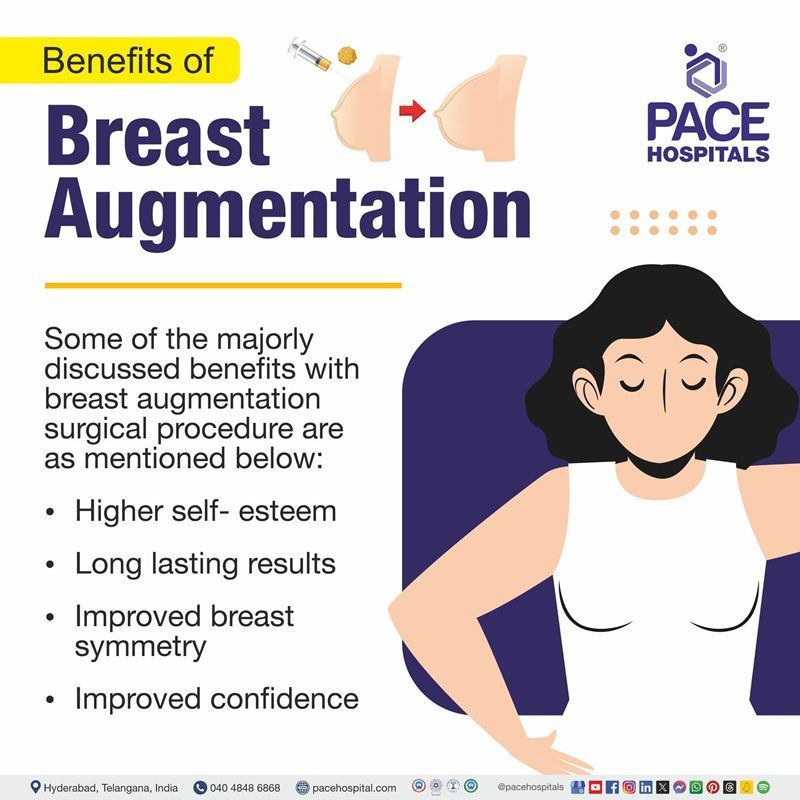
Benefits of breast augmentation
Some of the majorly discussed benefits with breast augmentation surgical procedure are as enclosed below:
- Higher self- esteem
- Long lasting results
- Improved breast symmetry
- Improved confidence
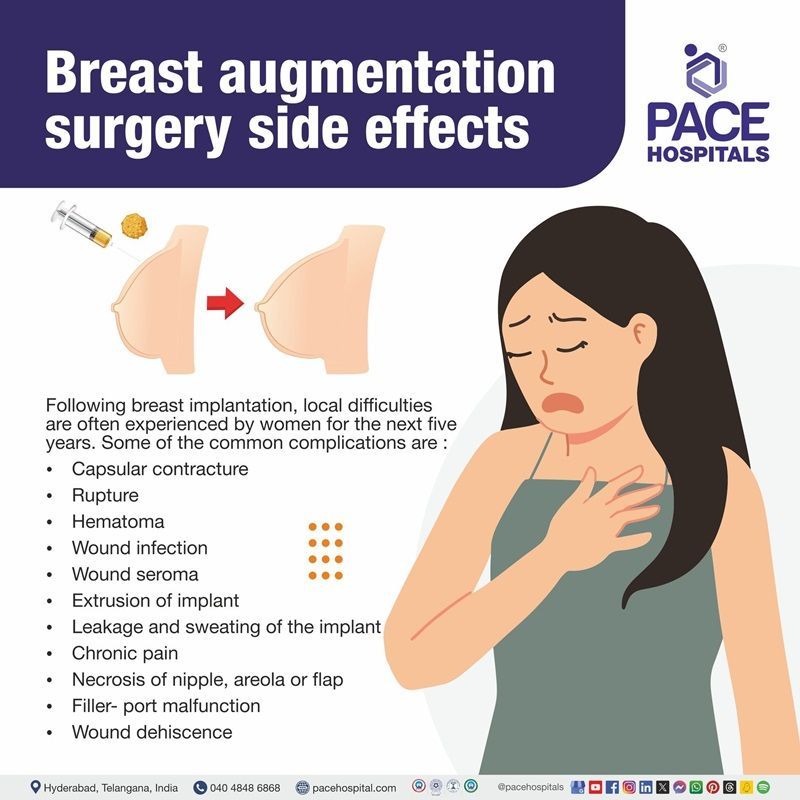
Breast augmentation surgery side effects
Following breast implantation, local difficulties are often experienced by women for the next five years. Compared to patients who had implants following a mastectomy for cancer or as a cancer prophylactic measure, those who received implants for cosmetic purposes experienced much less complications. Some of the common complications are mentioned here:
- Capsular contracture
- Rupture
- Hematoma
- Wound infection
- Wound seroma
- Extrusion of the implant
- Leakage and sweating of the implant
- Chronic pain
- Necrosis of nipple, areola or flap
- Filler- port malfunction
- Wound dehiscence
Life after breast augmentation
Following augmentation surgery, a woman may see a significant increase in her own self-worth, confidence, and self-esteem due to increase in breast size. Following a breast augmentation, many patients say they feel much more confident in all facets of their lives and that they feel more feminine and beautiful. Since the implants are now a part of their body, it's critical to consider potential long-term effects on the new breasts due to changes in the body. Age, pregnancy, nursing, and weight gain can all have a negative effect on how the breasts look. Breast augmentation exercises after surgery would help to handle the long-term effects to some extent.
How is breast augmentation surgery done?
Breast implants can be placed in a few different ways: The most popular method involves the surgeon creating an incision in the breast's natural skin fold on the bottom. Through this incision, the surgeon inserts the implant.
How safe is breast augmentation surgery?
Breast augmentation surgery is usually safe, with risks possible rarely. However, the regulatory authorities like the USFDA have done some extensive testing before approving the augmentation technique.
What is breast augmentation surgery?
Breast augmentation is done by placing implants behind breast tissue or under the chest muscle. An implant is a sac filled with either sterile salt water (saline) or a material called silicone.
Breast augmentation is a type of breast Implantation where the implants are positioned beneath the chest muscle or behind breast tissue to enhance breast size. An implant is a sac that is either filled with silicone or sterile salt water, or saline.
Frequently Asked Questions (FAQs) on Breast Augmentation Surgery
Is breast augmentation considered major surgery?
Indeed, augmentation of the breast is regarded as major surgery. To improve the breasts' size, shape, or symmetry, artificial implants are inserted. The procedure is often carried out under general anesthesia.
How long is breast augmentation surgery?
The surgical plan will determine based on how long the breast augmentation takes, but it should take no more than one or two hours. Surgery could take up to three hours or more in more complicated situations, such as those involving a combined breast lift or the removal and replacement of breast implants. Patients will be under general anesthesia and under close observation in the operating room during this time.
How long do the results of breast augmentation last?
While breast implants can last many years, they are not lifetime devices. Many women choose to replace their implants every 10 to 15 years due to changes in aesthetics, personal preference, or complications such as rupture.
How long is the recovery period of breast augmentation?
Recovery from breast augmentation typically takes about 1 to 2 weeks for initial healing, but complete recovery may take several months. Patients can usually return to normal activities within a week, though strenuous exercise should be avoided for a longer period.
Can I breastfeed after augmentation?
Most women can breastfeed after breast augmentation, though individual experiences vary. It’s important to discuss your plans with your surgeon to understand any potential impact on breastfeeding.
Is breast augmentation surgery safe?
The vast majority of people with breast implants experiences no serious complications. As per the American society of plastic surgeons, 98% of women who has undergone the surgery are satisfactory with no complaints in future as well.
How to sleep after breast augmentation surgery?
The ideal posture for sleeping following breast augmentation generally is to sleep on their back in a recliner or on pillows with the upper body slightly raised. In addition to preventing extra strain on the chest and minimizing stress or irritation near the incisions, this position helps to avoid fluid buildup.
Will I have scars after breast augmentation surgery?
Scarring is an inherent part of any surgical procedure. However, skilled surgeons aim to minimize visible scars by placing incisions in discreet locations. Scars typically fade over time and become less noticeable, especially with proper post-operative care.
Can I combine breast augmentation with other procedures?
Yes, breast augmentation can be combined with other cosmetic procedures, such as a breast lift or tummy tuck. Many patients choose this option for a more comprehensive transformation. Discuss your goals with your surgeon for the best approach.
What is the success rate of breast augmentation surgery procedure?
Breast augmentation surgery has a proven track record of success. Studies consistently show high patient satisfaction rates. For instance, one study found that 98% of women were pleased with their results. Additionally, another study reported that 80% of patients were satisfied with their breast appearance and 86% were overall satisfied with the outcome.
Beyond cosmetic improvements, many patients also experience significant benefits in terms of their self-esteem, quality of life, psychosocial well-being, and sexual well-being following breast augmentation surgery.
How much does a breast augmentation surgery cost in Hyderabad, India?
Breast augmentation surgery cost in Hyderabad can vary from ₹1,85,000 and ₹3,60,000 (US$2200 to US$4280), based on several factors, including the hospital's facilities, the complexity of the procedure, type of implants (silicone or saline), surgical & anaesthesia fees, medications and post-surgery care, corporate or insurance approval.
It is important to consult with a plastic and cosmetic surgeon to get an accurate estimate for specific needs and expectations.

